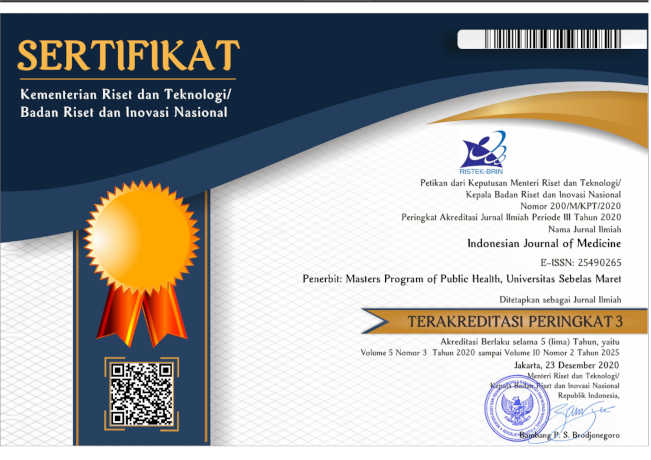The Effect of Simvastatin on Nitric Oxide and hs-CRP Levels in patients with Liver Cirrhosis at Dr. Moewardi Hospital, Surakarta
DOI:
https://doi.org/10.26911/theijmed.2019.4.1.148Abstract
Background: The prevalence of liver cirrhosis (SH) worldwide is at seventh place as the cause of death. Increased pressure in the portal vein Portal Hypertension (HP) causes esophageal varices and the more likely the patient to bleed. Endothelial dysfunction in cirrhosis of the liver causes a decrease in nitric oxide (NO) levels resulting in an imbalance between relaxation factors and portal vein contractions and increasing hs-CRP levels. Simvastatin can increase NO levels and improve endothelial dysfunction in patients with SH and can reduce levels of hs-CRP. This study aimed to determine the effect of simvastatin administration on nitric oxide and hs-CRP level in patients with liver cirrhosis.
Subjects and Method: This was a randomized controlled trial conducted at Dr. Moewardi hospital, Surakarta, Central Java. A sample of 29 patients was divided into treatment and control groups. 14 patients in the treatment group were given simvastatin dose of 20 mg. 15 patients in the control group received a placebo. The dependent variable was a nitric oxide and hs-CRP levels. The independent variable was Simvastatin administration. Nitric oxide serum level was measured by an enzyme-linked immunosorbent assay (ELISA). Hs-CRP level was measured by the immunechemiluminescent method. The data were analyzed by t-test.
Results: NO level after Simvastatin 20 mg administration (Mean= 7.93 µg/mL; SD= 1.78 µg/ mL) was higher than before (Mean= 5.14 µg/mL; SD= 2.25 µg/mL) and it was statistically significant (p = 0.001). Hs-CRP level after Simvastatin 20 mg administration (Mean= 2.04 mg/L; SD= 0.80 mg/L) was lowered than before (Mean= 7.82 mg/L; SD= 1.15 mg/L) and it was statistically significant (p= 0.001).
Conclusion: Simvastatin administration increases NO serum levels and reduces the hs-CRP level in patients with liver cirrhosis.
Keywords: nitric oxide, hs-CRP, simvastatin, liver cirrhosis
Correspondence: Budhi Hariyanto. Masters Program in Family Medicine, Universitas Sebelas Maret. Jl. Ir Sutami 36A, Surakarta 57126, Centra Java. Email: antohariyanto787@gmail.com. Mobile: 082328010442.
Indonesian Journal of Medicine (2019), 4(1): 9-14
https://doi.org/10.26911/theijmed.2019.04.01.02
References
Abraldes JG, Rodriguez-Vilarrupla A, Graupera M (2007). Simvastatin treatment improves liver sinusoidal endothelial dysfunction in CCl4 cir-rhotic rats. J Hepatol.46: 1040–1046. doi: 10.1016/j.jhep.2007.01.020 Crossref PubMed Google Scholar
Dahlan MS (2009). Menggunakan rumus besar sampel secara benar. Dalam: Dewi J (ed). Besar sampel dan cara pengambilan sampel dalam penelitian kedokteran dan kesehatan. Salemba Medika. Jakarta. Edisi 2.
Dıez RR, Raquel RD, Lavoz C, Mateos SR, Civantos E, Vita JR, et al. Statins Inhibit Angiotensin II/Smad Pathway and Related Vascular Fibrosis, by a TGF-b-Independent Process. PLoS ONE 5(11): e14145. doi: 10.1371/journal.pone.0014145 Crossref PubMed Google Scholar
Franchis R (2005). Evolving. Consensus In Portal Hypertension Report Of The Baveno IV Consensus Workshop On Methodology Of Diagnosis And Therapy In Portal Hypertension. J Hepatol. 43: 167–176. doi: 10.1016/j.jhep.2005.05.009 Crossref PubMed Google Scholar
FrancozC,Glotz D, Moreau R, Durand F (2010). The evaluation of renal function and disease in patients with cirrhosis.Journal of Hepatology. (52): 605–613. doi: 10.1016/j.jhep.2009.11.025 Crossref PubMed Google Scholar
Gulberg V, Moller S, Gerbes A, Henriksen JH (2000). Increased Renal production of Natriuretic Peptide (CNP) in Patients with Cirrhosis and Func-tional Renal Failure. Gut. 47:852-857. doi: 10.1136/gut.47.6.852 Crossref PubMed Google Scholar
Guntur HA (2008). SIRS, sepsis dan syok septic imunologi, diagnosis dan penatalaksanaan. Dalam: Guntur. Perspektif masa depan imunologi-infeksi. Sebelas Maret University Press. Surakarta.
Garcia-Pagan JC, Feu F, Bosch J, et al. (2001). Propranolol compared with propranolol plus isosorbide-5-mononitrate for portal hypertension incirrhosis. A randomized controlled study. Ann Intern Med. 114: 869–873. doi: 10.7326/0003-4819-114-10-869 Crossref PubMed Google Scholar
Laufs U, Liao JK (2000). Vascular Effects of HMG-CoA Reductase Inhibitors Trends in Cardiovascular. Medicine. 10(4): 143–148. doi: 10.1016/S1050-1738(00)00044-X Crossref PubMed Google Scholar
Mason JC (2003). Statins And Their Role In Vascular Protection. Clinical Sci-ence. 105: 251–266. doi: 10.1042/CS20030148 Crossref PubMed Google Scholar
Rajat SB, Ambrose JA, Srivastava S, De-Voe MC, Reynolds LJE. Direct (2003). Reactive Oxygen Species Are Involved in Smoking-Induced Dysfunction of Nitric Oxide Biosynthesis and Up-regulation of Endothelial Nitric Oxide Synthase An In Vitro Demonstration in Human Coronary Artery Endothelial Cells. Circulation. (107): 2342-2347. doi: 10.1161/01.CIR.0000066691.52789.BE Crossref PubMed Google Scholar
Santjaka A (2011). Teknik sampling. dalam: Sigit H, Abay F (editors). Statistik untuk penelitian kesehatan. Nuha Medika. Yogyakarta. Edisi I.
Suciu M (2009). The role of nitric oxide (NO) and statins in endothelial dys-function and atherosclerosis. Farmacia. 57(2): 131-140. Google Scholar
Trocha M, Anna ML, Szuba A, Chlebda E, Piesniewska M, Sozañski T, et al (2010). Effect of simvastatin on nitric oxide synthases (eNOS, iNOS) and arginine and its derivatives (ADMA, SDMA) in ischemia/reperfusion injury in rat liver.Pharma-cological Reports. 62:343-351. doi: 10.5114/aoms.2013.38087 Crossref PubMed Google Scholar
Zhang Z, Wang M, Xue SJ, Liu DH, Tang YB (2012). Simvastatin Ameliorates Angiotensin II-Induced Endothelial Dysfunction Through Restoration of Rho-BH4-eNOS-NO Pathway. Cardiovasc Drugs Ther. 26(1): 31-40. doi: 10.1007/s10557-011-6351-3 Crossref PubMed Google Scholar











